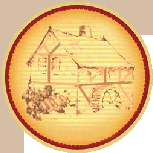by Les Saidel - August, 2010
The atmosphere of an old fashioned, traditional bakery - like Saidels Bakery - has an unmistakeable romance. To watch the flames kiss the bricks of a masonry oven seems to trigger a subconcious memory of a time when life was simpler and more serene.
The brick or "hearth" oven has held a central place both in the home and in the community over the generations. It served as a communal gathering place for the villagers to meet and exchange the latest news and in the home, served as the gathering spot for the family to sit around on cold nights to enjoy quality time. This was the focus of the home and the village. In fact the Latin word "focus" means "hearth".
But is it just romance? Or does a brick oven hold other benefits for the artisan baker?
Ancient civilizations since time immemorial, have been using brick in some form to bake bread. From the heated rock, to the famous Roman oven, the Indian Tandoor to the medieval communal brick ovens - all have some intricate connection to bread baking.
Modern scientific research casts some light on this ancient technology and reveals how this lo-tech alternative still dominates modern attempts at duplication.
In most ovens, ancient and modern, heat is transferred to the food being cooked in three different ways - conduction, convection and radiation.
Conduction occurs when a hot object (oven wall/tray) touches a cooler object (food). The heat flows from the hot object to the cooler one using the principles of thermodynamcics.
Convection is a similar process, except that there is no direct contact between the hot object and the cooler object. Instead, heat flows through an intermediary medium, a liquid or a gas (air) until it reaches the cooler object and the heat is indirectly transferred. A modern convection oven uses a fan to circulate the hot air around the food.
Radiation is a direct heat flow process using waves that does not rely on contact or a transfer medium. It is the way the sun heats the earth, for example.
All ovens that we know use these three principles to cook and bake, however the brick oven differs in one significant respect - the amount and type of radiation energy.
Due to its enormous thermal mass (the thickness of the fire brick and covering that, the massive refractory cement layer), the brick oven can provide a huge quantity of radiation in a short time that no metal walled oven is capable of producing. In addition, the wavelength of the radiation provided by the bricks is longer. These long waves penetrate the bread quicker than short length waves produced by a glowing electrical element.
Finally, the brick oven is constructed in such a way that the steam generated by the baking object is trapped within the oven and does not escape like in a normal kitchen oven (which even sometimes vents the air out).
These factors of increased radiation energy and abundant steam combine to produce a crispier, crustier bread that experiences greater "oven spring" i.e it rises higher when baking in the oven.
Modern commercial ovens try to duplicate the brick oven's functionality by installing brick hearth floors and even a brick roof on each baking layer. They also have computer controlled steam injection systems to keep the moisture level in the oven at the required level.
The truth though, is that a copy is never as good as the original. The brick oven is therefore the choice for artisan bakers who want to bake world class quality bread.
The romance of a brick oven is undeniable, but brick ovens also harbor a solid scientific basis that modern technology has not been able to improve on.
Just like the ancient Roman architectural arch, the brick oven is ancient man's contribution to future generations allowing them to continue to create bread (and other food) of unsurpassed quality.
We welcome you to come visit our bakery and see our famous brick oven. The oven is an Alan Scott original and is one of only two Scott designed ovens in the entire Middle East. Alan Scott was (he tragically passed away soon after we opened our bakery) one of the world leading experts in masonry oven construction. The brick oven is the largest in the Shomron and one of the 3 largest brick ovens in Israel. The oven, designed both for heating with wood or gas, uses a gas burner (for reducing harmful emissions) as its heat source.
It is a wonder of ancient and modern construction. The traditional facade is made from 200 hundred year old red bricks imported from Belgium and the actual oven itself combines the the knowledge of centuries of construction with the most modern techological innovations in both materials and devices.
At the end of the day however, all the above info becomes totally irrelevant when you simply gaze at the flames and feel the glow and warmth and the worries of the day just disappear.
Les Saidel
© Copyright. All rights in the above articles are reserved to the author Les Saidel.
No part of this website or the above articles may be transmitted in any form or by any
means without permission in writing from the author.




